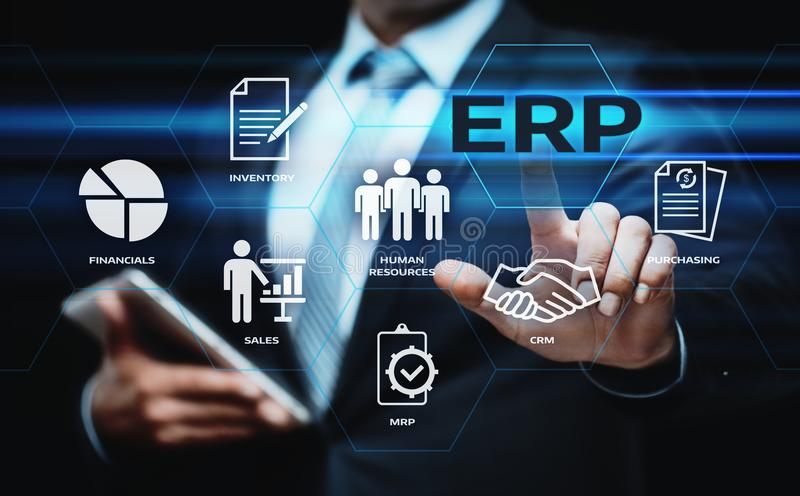Enterprise Resource Planning (ERP) software ( also called PGI) combines several functionalities within a single tool. But concretely, how is it used? How does Enterprise Resource Planning work in an organization? What are its daily advantages for your employees and your organization?
ERP software: bricks of functionality
The purpose of ERP software is to compile all of your data and management tools for all your departments in a single tool: purchasing, sales, stock, production management, accounting, management control, suppliers, etc. For this, it is composed of corresponding modules – also called bricks – which work both separately and together.
ERP software comes in the form of a platform, with a dashboard displaying different performance indicators according to your needs. In this way, each department knows in real time and day after day the data essential to its decision-making.
Enterprise Resource Planning also secure your data through automated entry in most cases. You thus avoid input errors (involuntary or voluntary), duplicates, loss of data, and your employees save time. They can then concentrate on tasks with higher added value such as decision-making thanks to the processing of data on the ERP dashboard.
How does the integration of ERP software into your IT system take place?
Do you want to integrate a software package into your system but are worried about losing data? The implementation of an ERP goes through an integration phase whose protocols are fundamental. One of these steps is called data recovery. All your information must indeed be transferred from one system to another, with all the risks that this entails if the integration is poorly executed.
You will have to transfer all your information on your:
- Suppliers
- Clients
- Invoices
- Orders
- Accounting
- Structural data
- Etc.
In other words, and to save you from cold sweats, the company and the integrator you choose will have to determine the best access route for the transfer. This means that they must not only know their tool perfectly, but also yours.
Of course, data recovery in an SME and in a large group does not generate the same level of difficulty. However, whether it is a small or a very large company, proportionally, the risks are the same.
An ERP or PGI is therefore an IT solution that unifies, according to your needs, different management modules and thus generates more productivity. To work, it must first integrate your own data. And this, in the best technical and safety conditions.
Must Read: Top 7 Technology Trends In ERP Systems
How ERP works in an organization
ERP utilizes a centralized database for many business methods to lessen manual labor. It works to simplify business workflow in the best way. It consists of a dashboard on which users can access real time online data collected from several departments. NetSuite is a best example of ERP system software.
Enterprise Resource Planning also aids in business analysis and measuring profitability and productivity. For example, a supply chain solution for ERP receives custom orders and then sends that information to the primary center automatically in order to complete your business in time. Data is siloed by the departments without an ERP system and it can be difficult to access the whole company.
ERP vs. CRM: What’s the difference?
An ERP system is similar to a CRM system in that both collect and standardize data and improve the efficiency of business processes. However, they each serve a very different purpose.
A customer relationship management (CRM) system records and stores every piece of information regarding interactions with your customers. For example, an outbound sales team member might enter new information, such as contact information, after a call with a prospect. Then, a member of the marketing department can use this information to create a new personalized newsletter.
ERP software is also designed to streamline business operations, but an ERP system focuses on reducing costs by making business processes more efficient. The basic difference between ERP and CRM is that CRM mainly focuses on sales and customer service while Enterprise Resource Planning is integrated and implemented across multiple departments.
In fact, both CRMs and ERPs are essential data repositories that can be used to increase the overall profitability of your business. These systems overlap in some areas. And although they are sometimes built on the same platform, software is often purchased separately and integrated when needed.
Benefits of ERP
How does an ERP help you make sense of your business data?
Think of your business activities as the engine components of a car. Being able to look under the hood can help you make preventive maintenance and upgrade decisions before you end up in the garage with a broken transmission. An ERP provides a centralized data system that gives you this necessary visibility.
However, if your online storefront is not integrated with an Enterprise Resource Planning system, it is more difficult to “look under the hood” because major data types, such as shipping/tracking, inventory, client details and execution, are all linked to independent systems that do not necessarily communicate with each other.
According torapport 2020 ERP d’Accenture, nearly 40% of chief information officers (CIOs) say it is not easy for them to access corporate and customer data to make business decisions.
ERP systems help solve this problem by consolidating and synchronizing the software you use across your business, allowing you to store data in one central place and track key performance indicators. (KPI) in real time.
ERP integration also eliminates the risk of data duplication and ensures data integrity by creating a single source of truth. This results in better organizational alignment and improved productivity, as people spend less time searching for needed data.
Enterprise Resource Planning software can help you save money by:
- Reducing operational data entry costs
- Increasing supply chain efficiency
- Streamlining collaboration between departments
- Providing smarter business intelligence
By creating a single source of truth in your business, ERP gives you access to real-time information in one place, allowing you to identify patterns and predict trends more accurately than previously possible. otherwise possible.
Read Also: Top 7 Technology Trends In ERP Systems
Types of ERP systems
Although not generally marketed as such, Enterprise Resource Planning software can be divided into a few different categories. Understanding what makes these ERP categories different and what each of them can offer will help you understand the current landscape and determine which type of ERP is best suited for your business.
On-premises ERP solutions
We speak of on-premises ERP when the company owns the data center. On-premises software can be purchased for a one-time fee or a perpetual license and can be hosted internally or externally.
The characteristics of on-premises Enterprise Resource Planning systems are as follows:
- Installed locally on a company’s computers and servers.
- The company is responsible for hosting, maintenance, software updates and operational costs
- Data security is the responsibility of the company
- Some systems require customization, making changes difficult.
- Deployment can take months or years.
Most legacy systems are considered on-premises systems, and larger companies are still recommended to use an on-premises ERP, as they have the money and resources to handle infrastructure maintenance and changes. .
Cloud ERP software (ERP Cloud)
Similar to other technologies, in recent years there has been a shift from on-premise software to cloud-based software, which is hosted in data centers and has a platform managed by vendors. Access to cloud ERP systems is via the internet, instead of a local computer or installed software, and they typically use a subscription pricing model.
The characteristics of Cloud ERP systems are as follows:
- Hosted in the cloud and can be deployed as a hosted model or software as a service (SaaS).
- Hosting, server, maintenance and software updates are included.
- Data security is the responsibility of the cloud provider
- Ease of integration with third-party systems and speed of change.
- Shorter deployment times and scalability as needed
- With a cloud-based ERP system, you can access your business data anywhere, anytime, and from any device. Better yet, a cloud ERPcan cost up to 46%cheaper than a comparable on-premises solution.
Two-tier ERP systems
In the past, companies deployed a single Enterprise Resource Planning system for their entire organization, from regional offices to headquarters. But this one-size-fits-all approach can be expensive and difficult to implement, making it less than ideal for many businesses today.
Two-tier ERP systems offer a potential solution by allowing organizations to use their current legacy ERP systems (Tier 1) while smaller business units use a different, often cloud-based ERP solution (Tier 2). To meet this need, several cloud solutions now have integrations to work with Enterprise Resource Planning systems and ensure that data flows between the two tiers securely and efficiently.
Ultimately, choosing the right product and the right supplier depends on understanding the unique needs and operating procedures of your business. Every business is different, but an ERP system can help solve common problems that most organizations face at one time or another. ERPs are an invaluable tool to help you improve operational efficiency and better prepare for the next curveball that comes your way.



